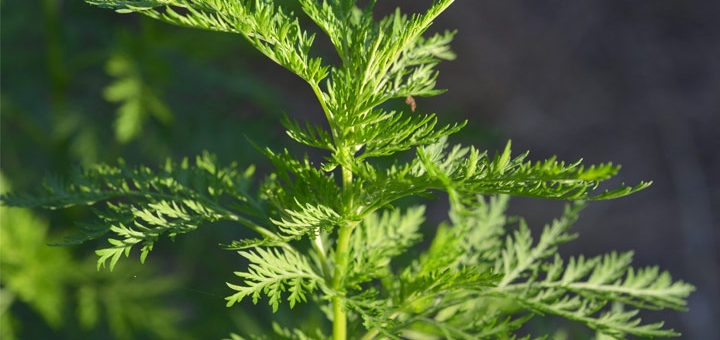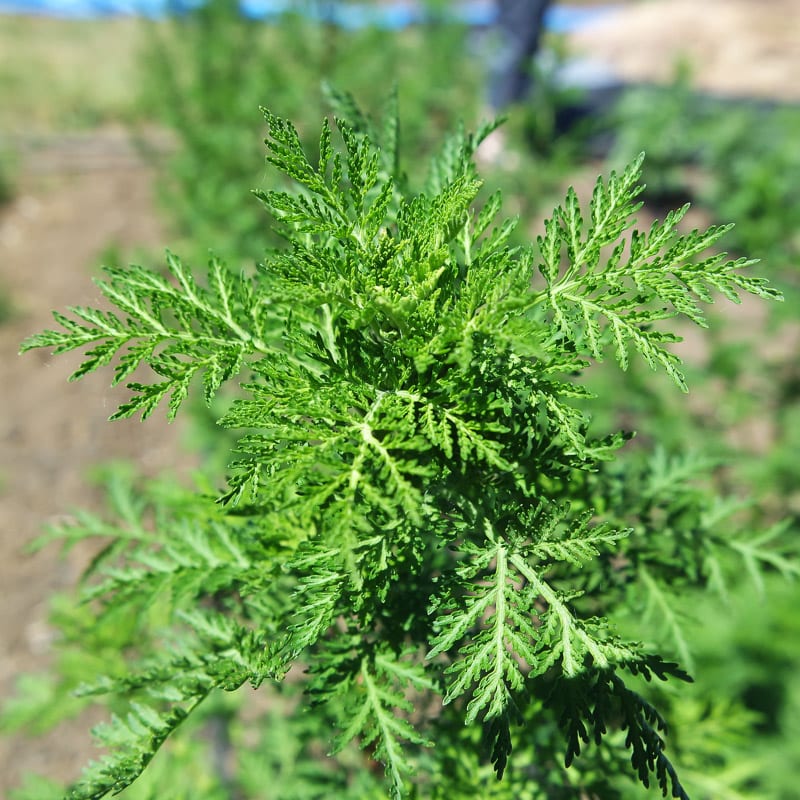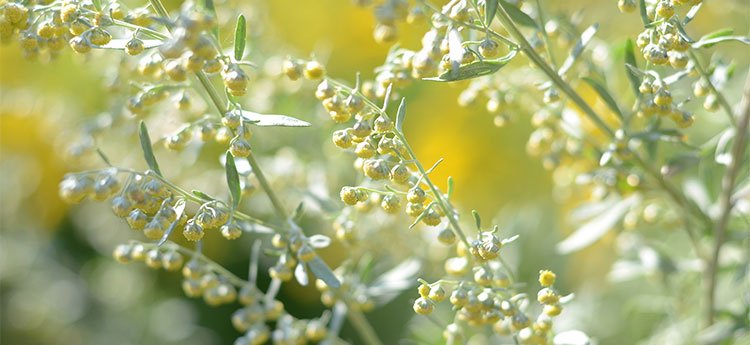Botanical description
The annual mugwort is not a plant from our region, although you will find it naturalized in certain regions of France: Provence, Languedoc-Roussillon, and Vallée du Rhone in particular (1).
It is an annual plant, as its name suggests, of the Asteraceae family.
The plant can grow very tall. I have had plants that are 2m tall in my garden in the past and know they can sometimes reach 3m.
And watch how well it grows in pots too, so we can grow it on a sunny balcony.
The plant has very branched stems. The leaves are very divided.
It's an Asteraceae, so the flowers are actually flower heads. They are small, say 1 to 2 mm in diameter, yellow in color and they are located in clusters.
Throughout this article, you will find photos to illustrate this description.
The plant loves full sun and does not need rich soil. On the contrary, a poor land will do very well.
No need for a lot of water once it's established. She doesn't seem to catch any diseases, she reseeds very easily, so this is an incredible gift from nature for a plant that has such therapeutic potential.
Update: following receipt of a comment from Lucile Cornet-Vernet:
The germination and the size of the plants are unfortunately not the same in Africa… difficult germination, incomprehensible dormancy of the seeds and the size of the plant often smaller…. There it must also be watered morning and evening! Year after year it adapts but it takes a long time!
Try this natural treatment for malaria and cancer!!
It is a plant that has a long history of use in Chinese medicine. It is also found in Ayurvedic medicine with a common and very interesting indication: it was used for what was called intermittent fevers.
In other words, the person has a fever flare, then a fever-free period, then the fever comes back, etc. Malaria creates this type of fever. So already, a few millennia in our past, we were probably using annual mugwort for malaria-type infections.
More recently we had an important episode that happened in 1967 during the Vietnam War. Hô Chí Minh asks for help from China because its soldiers perish more from malaria than from bullets from American soldiers.
China, at the time, also had major malaria problems in its southern provinces. The government therefore decides to launch a research program which it calls Project 523. Hundreds of scientists will work on it.
In 1969, a certain Tu Youyou took the head of the project. You may know her name because she received the Nobel Prize in Medicine in 2015 for her work on Artemisia annua and malaria.
At the time, pharmaceutical companies around the world were looking for a molecule to fight malaria. Indeed, the disease was becoming increasingly resistant to chloroquine, a derivative of quinine obtained from the bark of cinchona.
The labs were testing thousands of molecules, a bit like a steamroller, a bit at random, to see if we were going to find the miracle molecule.
Tu Youyou, she turned to tradition and old writings. This is how she rediscovered the annual mugwort. She also noticed that in the regions of China where the plant was used, there was no problem of malaria.
It will also extract one of the active substances, artemisinin, the substance we talk about the most today. And to complete this story with Vietnam, the Chinese sent stocks of annual mugwort to the troops of Ho Chí Minh and his malaria problem was resolved. As easy as that.

The situation today is a bit complicated. I will try to summarize it for you as best as possible.
The plant has many properties, but we will focus on only 2, the two most interesting.
? It is a formidable antimalarial . It destroys the parasite responsible for the disease, the plasmodium which circulates in the blood. We have well established protocols in terms of dosage and duration, I will describe them to you below.
? It is probably an effective anti-cancer but for which we have much less experience and experience with regard to dosages, duration of intake, etc.
So I suggest you take these topics one by one and go into details.
Try this natural treatment for malaria and cancer!!
Artemisia defeats malaria
The plant contains a substance called artemisinin which can be isolated today. This substance has been studied extensively.
Here's what you need to know:
- Isolated artemisinin works to treat malaria;
- The whole plant also works very well;
- The whole plant from which artemisinin was removed also works.
I would like to emphasize this last point because we do not talk about it enough today. Moreover, we see that another artemisia, Artemisia afra , is also very effective against malaria and it does not contain artemisinin (3).
This means that once again the obsession with the active component cannot work!
There were more than 400 components in the plant, more than 20 are malaria . It is this richness that makes it effective.
It is this richness that means that the parasite responsible for malaria will not be able to adapt as it does so well when there is only one molecule.
In addition, artemisinin is expensive. It takes a lab to extract it.
By denigrating the whole plant and the simple forms like infusion, we therefore prevent the local populations of Africa, Asia and South America from regaining their health in hand. I find it really sad knowing that children die from malaria every day.
Fortunately, the local populations did not wait for the blessing of Europeans and Americans to do their own experiments and see how effective the infusion is!

Anti-malaria protocol
The information I'm going to give you comes from different sources:
- ANAMED, an NGO very involved in artemisia projects;
- La Maison de l'Artemisia, a magnificent French project by Lucille Cornet-Vernet;
- Stephen Buhner in the United States and his research on antiparasitic plants.
Here are the different shapes that can be used:
? Infusion of dry plant . 5 g are used for one liter of water. We can also dose a little less precisely when we have nothing to weigh and do with the handle, which generally gives us between 5 and 10 g.
Leave to infuse for 15 minutes, covered. Then we filter and drink in 3 or 4 doses during the day. Cure of 7 days, the longer is not necessary, the less time is problematic. Indeed, we must not stop before otherwise there are parasites in the blood.
Buhner explains that artemisinin is best extracted if there are lipids. He therefore advises to use an infusion in whole milk and explains that this will extract 80% of the artemisinin compared to 25% for the infusion in water. Obviously, in poor countries, we will simply use water.
? Tincture of fresh plant . The fresh plant is cut into very small pieces and 200 ml of pure alcohol (96 ° alcohol if possible, 80 ° minimum) are used for 100 g of fresh plant.
We place a clean stone on the plant, in the jar, so that the alcohol covers the plant well. We let macerate for 2 weeks, filter, press. The doses are 1 tablespoon of tincture in water 2 times a day for 7 days (Buhner).
? Fresh plant juice , again not within the reach of everyone because you need an extractor. Buhner recommends 1 tablespoon of the juice per day, in water, for 7 days.
Buhner explains that the juice is 6 to 17 times more potent than pure artemisinin. It makes you think.
Try this natural treatment for malaria and cancer!!

? Cold maceration . It is the ancestral form discovered by Tu Youyou. We let the plant macerate in cold water for several hours, then we press the plant to extract as much juice as possible and we will drink during the day.
Buhner gives a slightly different method: start with 100 g of fresh plant, pour ½ liter of hot water over it (be careful not boiling, hot water) and let macerate for 12 hours. Then squeeze well and drink during the day.
If you want the simple method, it is the one described by ANAMED and the Maison de l'Artemisia, 5 g of dry plant for a liter, or a handful, in infusion.
Results : fever, headaches, muscle aches disappear on the first or second day. It works fast and well.
Please note : Buhner recommends a second one-week treatment 2 weeks after the first treatment. So you do the one week cure, you let 2 weeks pass, then you redo the same one week cure. I did not find this recommendation in my other sources, it is a Buhner specificity.
Efficacy : a study sponsored by the Maison de l'Artemisia in Congo (2), a randomized double-blind study, shows that under artemisia annua, the cure rate of malaria is 99.5%!
Whereas the cure rate if using a combination of an artemisinin derivative, called artesunate, and an antimalarial drug (treatment called ACT) is 79.5%. Doesn't it make you think?

? ANAMED recommends 1.25 g of dry herb infusion , which is approximately one teaspoon of dry herb per 200 ml cup. You make an infusion covered, you let it steep for 15 minutes then you take this cup every day in the morning.
Be careful, you must drink the whole cup at once, you do not spread the intake throughout the day otherwise you will not have enough effect.
You start before departure and continue for 3 weeks after your return.
? The recommendations of the Maison de l'Artémisia are a little different. We will make a distinction with people who have already been in contact with malaria, and who therefore have a more acute immunity to the disease.
For those who have already been in contact with malaria: infusion twice a week during the rainy season.
For the tourist on the other hand, it would be better to take doses which turn around 5 g / L in infusion , therefore the curative dose, to drink the liter during the day, from the day before the trip until one week after the return.
Between the 1.25 g / day of ANAMED and the 5 g / day of Maison de l'Artemisia, there is a significant difference. Doctor Cornet-Vernet having a great experience in the matter, personally, if I had to do prevention for a trip, I think that I would follow his recommendations (5 g / day).
Please note : the medical profession does not support this type of approach and will tell you to take antimalarial drugs so as not to take risks.
So this is a very controversial approach (are you surprised?) And here I am not going to tell you what you should do, I am telling you what I would do personally based on my research. It's up to you to see and decide.
Note : both in attack and prevention, the effectiveness of the protocol will depend on the quality of the plant you use. If you use a plant that is too old, or of poor quality, it may not work well. This is the risk.
And since the plant is not authorized for sale in France, it is complicated to get it today.

As far as cancer is concerned, it is much less clear. It is especially artemisinin that has been studied.
First, we have many studies in vitro, that is, outside the body, in a test tube, which show that artemisinin destroys cancer cells of leukemia, breast cancer, cancer. colon, prostate cancer, etc.
We have dog studies for bone and lymph node cancer.
I'm not going to list all these studies for you, there are really a lot of them, done on many types of cancer cells.
For studies on humans, unfortunately, not much.
You have to look at the doctors who prescribe artemisinin and who dare to talk about it, there aren't many I can tell you.
A doctor in the United States talks about it, it is Doctor Len Saputo, he is very criticized as you can imagine.
He prescribes 200 to 500 mg of artemisinin per day, 4 days a week with 3 days off . These are doses lower than what one would take for malaria. In the context of malaria, we are talking about 800 to 1200 mg of artemisinin per day for 5 to 7 days (note that I am not talking about a whole plant here but rather isolated artemisinin).
Let's do the math for the whole plant.
The dry plant contains between 0.75% and 1.4% artemisinin (Buhner), so to have 200 mg of artemisinin, the low dose recommended by Saputo, you would need between 14 and 25 g of dry plant per day, in infusion for example.
But since there is a synergy of constituents in the whole plant, it is quite possible that lower doses will be effective.
So to summarize, we are really in the dark. As much as we have arrived at an effective protocol for malaria, for cancer we are swimming in murky waters.
Personally, if I suffered from cancer, I would come back to something simple, because the simple speaks to me. I would take the infusion of the plant, probably at doses around 5 to 10 g / L as a cure, probably every other week.
But this is only my opinion, I am absolutely not in a position to generalize anything at the moment.
Try this natural treatment for malaria and cancer!!

Then there is a whole discussion about taking iron with mugwort or artemisinin. It turns out that artemisinin produces its effect by associating with iron and creating strong oxidative stress which will destroy either the cancer cell or the plasmodium.
So the idea is to make the person take iron, cancer cells consume it (more than healthy cells), the plasmodium also consumes it through hemoglobin, so we try to saturate these cells with iron.
Then artemisinin comes in and causes destruction. Logical until then.
The problem is, iron can also feed cancer cells and Plasmodium directly. So again, there is nothing clear.
I like Doctor Saputo's position which I find reasonable: if the person is lacking iron based on a blood test, it is better to supplement because otherwise artemisinin will probably have difficulty doing its job. Otherwise it is probably not necessary to take iron.
We're now changing direction and we're going to talk about harvesting.
Some will tell you to harvest the aerial parts just before flowering. Others will tell you to harvest just at flowering because the flowers are also very rich in artemisinin (Buhner). There again no consensus.
Collect all the aerial parts, even the leaves that you think are the oldest and a little dry. In general, these mature leaves are at the bottom of the plant and are very high in artemisinin, richer than the young leaves.
You remove the larger branches, some can be quite sturdy, the branches are of no interest. You keep the finest twigs, and above all you keep all the leaves and flowers if you pick up just at the start of flowering.
Dry flat on a rack then store in paper bags away from light. Or you transform it in the fresh state to make a dye for example, we have already talked about it.

Try this natural treatment for malaria and cancer!!
- The plant sometimes creates a nauseous state, this is quite common;
- Much less common, some people say they have a spinning head, small intestinal pain, sometimes itching;
- Even less common, taking large doses, and here we are talking more about artemisinin, can cause inflammation of the liver, therefore elevation of hepatic markers;
- For taking during pregnancy, based on my research it is rather contraindicated.
- We have a study done in Africa on 16 pregnant women who took annual mugwort in their first trimester and there were no more miscarriages than usual. On the other hand, animal studies are more worrying, so for me it's not out of precautionary principle.
So much for artemisia annua, a very promising plant.
I hope that we will continue to use it in its natural form as a whole plant, that we will continue to help local people to cultivate and use it.
And for cancer, I hope that one day we will have more detailed protocols than what we have today. I have good hope.

Try this natural treatment for malaria and cancer!!